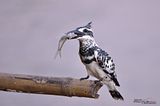This post goes back to the first Sunday of September, September 4th, when I joined a small monthly Bird Walk activity with my local Lanna Bird Club. This month's activity was held at Mae Hia Agricultural College, a well known birding site among birders in Chiang Mai. I arrived at the place around 7AM and there were already many people. The activity aims to promote birding especially to people in the city. The feedback has been very good so far and we were able to bring in many families with young kids. As soon as we started walking, we spotted a young Burmese Shrike, Ashy Woodswallows, a flock of Red-wattled Lapwings, Indochinese Bushlarks and a family of White-breasted Waterhen. As the sun was rising high up in the sky, I heard someone spotted a Black Baza (Aviceda leuphotes syama) perching nicely on a utility pole.





Black Baza (Aviceda leuphotes syama)





Although migrating through southern Thailand in a massive number every year, the Black Baza is still certainly not an easy raptor to see outside its migrating route. I've only seen it several times in Chiang Mai. The appearance of this bird at Mae Hia suddenly stirred up the atmosphere. Everyone stopped looking at the other birds and tried to approach the baza slowly with the best care afraid of scaring it away. It actually turned out that the bird was unexpectedly tame. Either it was exhausted from migration or an escapee, we weren't able to conclude that. After talking to a raptor expert, I know that the bird was a female of the migrating race A.l.syama judging from its 7 chestnut bands on its underparts. The resident race A.l.leuphotes (which I've seen nesting once near Ban Arunothai) has more chestnut and white patches on the wings with less chestnut barring and more buffish underparts.



It was first seen sunbathing on a utility pole.
After watching it for almost half an hour, the bird then flew down to the lower tamarind tree and stayed there for about 5 minutes before flying up to the pole again. A few Common Mynas didn't seem to enjoy having it nearby and began to call aggressively. The baza stayed on the pole for about 15 more minutes before flying out to the other pole then disappeared into the forest edge after being mobbed by a Black Drongo. It is also alternatively called Black-crested Lizard Hawk because it normally preys on lizards. There are 2 species of bazas in Thailand, another one is the brown Jerdon's Baza which is even more uncommon and I've still haven't seen it before.



























3 comments:
Wow, so you got that one but it is not that common, but what a capture mate. I mean this bird is gorgeous, I love its color pattern, its crest and look at its eyes! Wow I would love to see such a bird one day. Thanks for the ebautiful description and these wonderful pictures!
What a fantastic looking brd!
Bazas are so cool and this one is quite stunning in his black suit. Love the way his crest flops around in the video.
Post a Comment